Five AI professionals and tech-enthusiast - Germans Claus Wellenreuther, Hans-Werner Hector, Dietmar Hopp, Klaus Tschira, and Hasso Plattner employed with IBM quit their jobs to lay the foundation of Systemanalyse und Programmentwicklung in June 1972. That’s how System Analysis and Program Development, or SAP came into existence.
Initially, the journey of SAP commenced with a mere single client and few employees. But today, after 50 years, it is the global frontline and leading Enterprise Resource Planning Software vendor serving more than 245 million+ subscribers in the cloud user base and more than 22,000 SAP partner companies, fueling industry-wide digital transformation. In July 2014, it transformed its legal form into a European company, thus becoming SAP Deutschland SE & Co. KG.
“We have transformed enterprise software and redefined business innovations together.” says the company.
GoodFirms has come up with an in-depth and transparent review of SAP’s most popular software products, highlighting their explicit features, core benefits, and drawbacks and comparing SAP’s top alternatives. Also, this SAP review article will spotlight a few imperative questions, such as
- The most popular and in-demand SAP software and products
- Is SAP a top cloud vendor?
- Does it provide a full-proof and fortified security to protect data?
- Is SAP a viable option for small and mid-sized companies?
A Complete Review of SAP Software Products
SAP is a German-based top-notch business process management software that has established its prominence as the third-largest publicly traded software company in market capitalization. It has become the largest non-US-based software organization by revenue generation.
Over the last five decades, SAP has extensively built more than 260+ innovative products and acquired 70+ companies to strengthen its dominance in the software industry. In 2016, SAP achieved another incredible milestone when it became the fourth largest software company in the world.
SAP drifted its focus on promoting and selling cloud-based products through acquiring various companies and partnerships with tech giants, such as IBM. The company made hefty investments in the Internet of Things (IoT) technology to enhance its hold on the growing market. Subsequently, it penetrated other technology sectors like Artificial Intelligence, Blockchain, Machine Learning, Quantum Computing, Analytics, Database Management, and more.
SAP effectively serves several industries with a special focus on six major industries: consumer, discrete, financial, process, public, and services. In 2015, it unveiled a new advanced Business Suite SAP S/4HANA with cloud, on-premise, and hybrid deployment options.
GoodFirms has thoroughly and significantly reviewed all the key SAP products, starting with SAP ERP, followed by others. You can glance through the leading software solutions and all their subcategories here:-
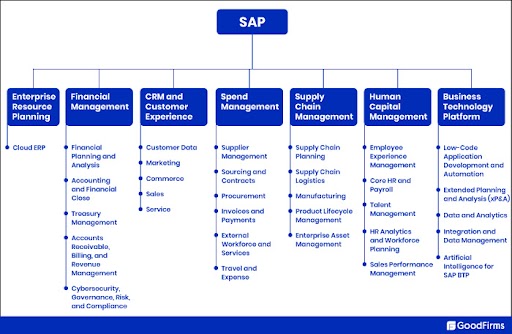
SAP has categorized all its critical products under
- Enterprise Resource Planning
- Financial Management
- CRM & Customer Experience
- Spend Management
- Supply Chain Management
- Human Capital Management
- Business Technology Platform
GoodFirms Review of SAP Enterprise Resource Planning
What started as a mere experimental project based on an enterprise system about five decades ago turned into a massively successful and popular product, making SAP one of the pioneers of Enterprise Resource Planning solutions. SAP ERP integrates all core business processes and functionalities into a unified system. The advanced ERP tool helps organizations streamline complex operations and access real-time insights. SAP Enterprise Resource Planning is available as a cloud, on-premise, and hybrid solution, allowing customers to select their preferred deployment model.
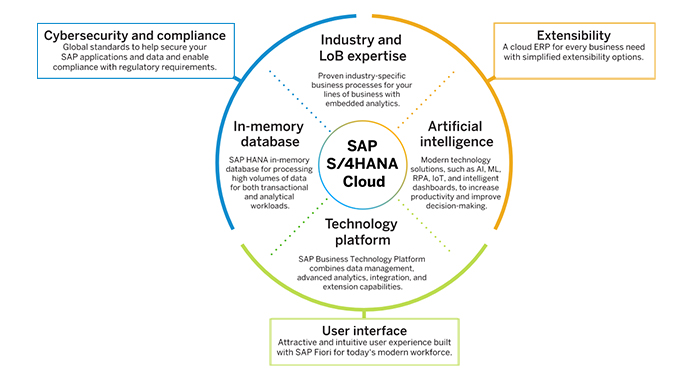
Image Source: SAP ERP
SAP ERP enables running all business processes, such as manufacturing, finance, sales, supply chain, procurement, services, asset management, engineering, research, and development. It specializes in effective data processing and centralized data management with a single source of truth. The ERP platform utilizes a common data store and closed integration, which makes the flow of information simpler from one module to another without using redundant data entry.
SAP ERP Cloud is available as Software-as-a-Service. Users can lease it on a yearly or monthly subscription basis. They don’t have to pay any other additional hardware costs, while SAP handles all maintenance, upgrades, and security-related tasks.
How Does SAP ERP Work?
SAP ERP is a premier and cutting-edge software that effortlessly manages and automates end-to-end business processes, such as manufacturing, sales, finance, supply chain, customer experience, etc., to allow organizations to unleash digital transformation and accomplish their goals.
SAP ERP provides powerful elements such as finance, supply chain, human resources, logistics, customer relationship management, business intelligence, etc., apart from a robust three-tier and client-server architecture that efficiently supports complex business processes. It has optimized its user interface with SAP Fiori providing the flexibility and compatibility to adopt multiple devices quickly.
Does SAP ERP Optimize and Simplify Business Operations?
SAP ERP Software can efficiently run real-time critical business functions from anywhere into a unified system. It automates the end-to-end core operations and helps to implement the industry best practices and hotbed technologies to stay ahead of the competition.
SAP ERP fosters constant innovation and improves speed to lower IT and maintenance expenses. It boosts organization-wide agility, where companies can focus on consolidating their growth, seize more opportunities, strengthen their customer relationships, and quickly respond to the changing digital business landscape.
The Four Main SAP ERP Products Include
- SAP ERP Central Component or SAP ECC
- SAP Cloud ERP or SAP S/4HANA
- SAP Business One
- SAP Business ByDesign
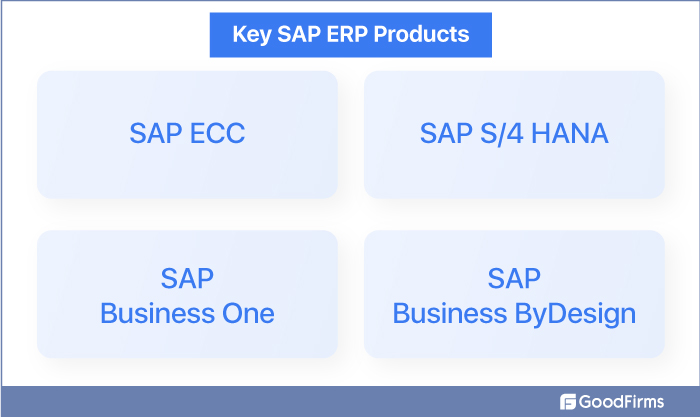
#1. SAP ERP Central Component or SAP ECC
SAP ECC or ERP Central Component is a next-generation on-premise enterprise resource planning software that seamlessly integrates all digital information and data stored in different places or company databases in real-time. Top management executives get a unified view of the business process to make data-driven decisions.
SAP ERP Central Component supports third-party databases, such as IBM DB2 and Oracle. It streamlines the end-to-end logistics and procurement process and escalates manufacturing operations. Organizations can look to curtail their overhead costs and automate data integration between two connected platforms.
SAP ECC can streamline all vital business processes due to its powerful and critical components, including Sales and Distribution (SD), Financial Accounting and Controlling (FICO), Material Management (MM), Production Planning (PP), Plant Maintenance (PM), Quality Management (QM), Project System (PS), and Human Capital Management (HCM).
Apart from these essential modules, SAP ECC includes a couple of technical components; NetWeaver and ABAP. The NetWeaver handles the system administration and allocates specific roles to individuals. On the other hand, ABAP helps customize reports based on specific business requirements. Both these modules are compulsory to implement SAP ECC.
Now that SAP has already introduced cloud-based S/4 HANA, it is urging all SAP ECC users to migrate to the advanced cloud ERP system. However, the company will continue supporting ECC until 2027 and provide operational maintenance until 2030.
#2. SAP S/4HANA
SAP S/4HANA is an immediate successor to SAP ERP Central Component that runs on the SAP HANA in-memory database, specifically developed for it. In two decades, the software was also regarded as SAP’s most important ERP strategy to upscale solutions. SAP S/4HANA was unveiled in 2015 as a new advanced Business Suite with triple deployment options; cloud, on-premise, and hybrid. Soon after the launch of SAP S/4HANA in February 2015, Gartner called this ERP system a ‘Transformational Shift’ but, at the same time, raised concerns regarding its functionality, pricing, migration, and availability.
Although SAP S/4HANA had made its way in 2015, the first cloud edition was released in March 2016. The latest version was unveiled in August 2022, the SAP S/4HANA Cloud 2208.
SAP introduced S/4 HANA, intending to digitize, accelerate, and simplify day-to-day organizational tasks. Also, SAP wanted to create a digital core ERP platform that could compete with Oracle ERP or NetSuite ERP. It has become SAP’s flagship ERP product and a completely modular software solution catering to all industry domains and business sizes.
SAP refers to its S/4 HANA model as an intelligent enterprise due to its integration with advanced technologies like artificial intelligence, machine learning, the internet of things, and advanced analytics. SAP S/4HANA allows organizations to modernize their business processes by creating new models to become more responsive and proactive in meeting customer expectations. It has become much easier for large organizations to acquire new companies into the ERP environment as SAP enables them to store all data on the public platform. It has introduced new capabilities, such as Global Available-to-Promise, allowing companies to easily and quickly globalize the available information across the system. Global ATP helps to minimize maintenance and ownership costs.
Gartner has recognized SAP S/4 HANA as a Leader in its 2022 Magic Quadrant report, while IDC MarketSpace has identified S/4 HANA software as the leading cloud-based operational ERP system.
SAP S/4HANA offers the modules the same as SAP ERP Central Component. We have highlighted the pivotal S/4 HANA modules below.
- Sales and Distribution (SD)- It covers and manages every aspect of the sales and distribution process. It further manages customer returns, billing, and credit insurance, focusing on product or service sales through direct customer or distribution networks.
- Financial Accounting (FI)- Financial accounting records and handles all transactions related to purchases and sales in one place. It also helps in reporting, cash management, reconciliation, etc.
- Controlling(CO)- Controlling deals with cost and financial planning, monitoring, and managing internal orders.
- Material Management (MM)- This SAP ECC component manages procurement tasks related to inventory. It also manages the transfer of materials, goods insurance, and all receipts.
- Supply Chain Management (SCM)- Build a robust and dynamic supply chain to gain visibility and agility in inventory management, customer orders, purchase, sales, and embedded transportation.
- Customer Relationship Management (CRM)- SAP customer relationship management (CRM) aims to augment customer experience by providing sales reps with a 360-degree view of potential customers. It aims to enhance customer retention, generate higher revenue, automate schedules and tasks, and establish better team collaboration.
- Enterprise Performance Management (EPM) is an essential SAP S/4HANA module that streamlines enterprise budgeting, forecasting, planning, and consolidation. SAP EPM includes S/4 HANA Group Reporting, SAP Analytics Cloud, and SAP Business Planning and Consolidation.
- Production Planning (PP)- The module helps organizations to align customer demands with manufacturing capacity. Production planning digs the data insights to more accurately and efficiently plan production processes by focusing on manufacturers’ supply chain capabilities.
- Plant Maintenance (PM)- It efficiently monitors and maintains the machines and other equipment by tracking their working condition. It ensures that all plant machinery is intact and running smoothly. It sends real-time alerts to the concerned departments if it detects any issues to prevent any disruption or failure.
- Investment Management (IM)-. The module plays a vital role in efficiently managing investments and capital expenditures. IM manages investments in fixed assets. SAP Treasury Module manages the financial support.
- Project System (PS)- The SAP ECC component effectively manages and handles large and complex projects like establishing a new production plant and its overall maintenance. It includes everything from managing the production costs to procuring raw materials, allowing organizations to stay within their budget estimate.
- Human Capital Management (HCM)- It handles all elements and tasks related to human resources, such as hiring, onboarding, employee management, payroll, time management, training, leave approvals, and workplace safety.
- Product Lifecycle Management (PLM)- Product Lifecycle Management enables organizations to design high-quality products triggered by faster and improved decisions to meet customer standards strictly. They can deliver products within the stipulated deadline.
- Customer Services (CS)- The customer service team gets all relevant data at their fingertips to deliver exceptional service by creating plans based on the latest trends.
In addition to these, SAP S/4HANA further includes various other modules, such as Logistics Information System (LIS), Strategic Enterprise Management (SEM), Environment Health and Safety (EHS), Supplier Relationship Management (SRM), and many more.
SAP S/4HANA Capabilities
SAP S/4HANA offers an extensive range of ERP capabilities that transforms companies into intelligent enterprises enabling them to redefine end-to-end processes.
Asset Management
The Enterprise Asset Management Software from SAP allows organizations to monitor every physical asset or equipment to nullify downtime and optimize its performance. SAP EAM solution provides comprehensive maintenance management, efficient planning, intelligent scheduling, and execution with the environment, health, and safety management. It offers real-time asset visualizations, geospatial workflows, and complete transparency into asset management.
Finance
Organizations can automate their entire finance process, from running intelligent accounting operations to unifying transactions and minimizing risk management. SAP ERP Finance provides real-time reporting and advanced analytics with AI-powered insights to drive decisions. Improve cash flows, and centralize account payables and receivables through financial operations. At the same time, cost management and profitability analysis helps to analyze costs and evaluate the profitability of the market and channels. It also includes enterprise risk & compliance, treasury & commodity management, subscription billing & revenue management, and real estate management.
Manufacturing
SAP S/4HANA manufacturing includes optimized product engineering and simplified product design to efficient product planning with capacity constraints and MRP stimulations. The software can increase operational efficiency and offer complete data visibility. Manufacturers can choose their preferred manufacturing model based on their needs, while AI-backed quality management provides complete control over manufacturing processes. Get real-time manufacturing insights to streamline the process. Protect the workforce and ensure utmost safety with intelligent devices and responsive systems.
R & D and Engineering
The feature enables manufacturers to create complex products and get a complete view of their development stages with product lifecycle management tools. To devise an accurate plan, the company can gain insight into vital metrics, such as the development cost, estimated time, critical resources, etc. Organizations can comply with product rules and regulations regarding marketing rights, selling, shipping, and transporting hazardous goods.
Sales
The Sales Software from SAP surges revenue by increasing the customer base. It empowers sales reps to close deals quickly from anywhere with complete CRM, order management, and pre-sales support. Sales managers can accurately review sales performance to set up monetary incentives. They can seamlessly manage sales orders and pricing, ensure data consistency and quickly process sales documents and contracts. SAP also provides an extended range of sales solutions, including SAP Marketing Cloud, SAP Sales Cloud, SAP Commerce Cloud, SAP Customer Data Cloud, and SAP Qualities.
Service
Deliver exceptional customer service to boost retention rates and earn loyalty for the long term. SAP S/4HANA Service is a one-stop shop for managing commercial and technical assistance with additional benefits of customer data tracking, seamless interaction, and complete analytics across the platform. The service managers can quickly assign tasks to the right technicians and provide them access to all data and equipment. The software helps to optimize spare parts efficiency, storage, and procurement. SAP Service platform deals with subscription management and financial shared services management.
Sourcing & Procurement
The sourcing and procurement system from SAP provides real-time insights into expenditure, suppliers, and current market trends. It helps you minimize supply risks by automating the workflow process. You also access all purchasing data through a centralized database while machine learning-powered analytics accurately forecasts contract consumption and enhances material management. The SAP feature provides automated recommendations for new catalog items and creating contracts. Apart from these, you can view all your invoices in one place, upload them seamlessly and process them through the intuitive user interface. The central procurement system reduces overall costs and enhances requisitioning across business units.
Supply Chain
SAP S/4HANA Supply Chain capabilities are a modern high-end solution that streamlines various business processes, such as inventory management, transportation management, logistics, order management, warehouse management, etc. It offers real-time visibility of sales, purchases, and stock of goods to efficiently plan and schedule the transit of goods. Similarly, warehouse management enables organizations to store all the products and improve asset usage efficiently. SAP logistics escalates the shipping process to deliver the items quickly and improve transportation. The supply chain also deals with logistics material identification, circular economy logistics, order promising, and service parts distribution.
SAP S/4HANA Pricing
| Product | Pricing |
| SAP S/4HANA On-Premise | SAP offers a 30-day free trial period, after which the license-based subscription starts. |
| SAP S/4HANA Cloud | SAP provides a 14-day free trial period, after which the license-based subscription starts. |
SAP ERP Solutions for Mid-Sized and Small Enterprises
SAP offers two specialized ERP solutions for mid-sized and small businesses to efficiently cater to all their requirements. They are
- SAP Business One
- SAP Business ByDesign
#3. SAP Business One
Founded and initiated in 1996 in Israel by Gadi Shamia and Reuven Agassi, TopManage was a business management product. Later, SAP purchased it in 2002 and renamed it SAP Business One. The acquisition of TopManage Financial System allowed SAP to partner with small and medium enterprises and provide a wide range of business solutions like sales, customer relationship management, inventory management, finance, reporting, etc., embedded with analytics, business intelligence, and on-premise or cloud deployment.
Here is a customer’s feedback shared with GoodFirms about SAP Business One.

The Core Features of SAP Business One
Financial Management- Streamline all your financial operations with optimized tools to upscale profitability and automate accounting processes, such as account payables and receivables. Efficiently manage the fixed assets and gain complete control over cash flows more accurately. The feature simplifies banking reconciliation, financial reporting, and analysis through customized reports, whereas real-time data helps to audit reports.
Sales & Customer Management- Proficiently manage the entire customer lifecycle and sales process from the initial interaction to after-sales support. Gain access to all the leads and opportunities throughout the sales cycle to create optimized marketing campaigns that help to convert visitors to potential customers. You can store all customer data in one place and manage warranty contracts and service agreements to respond to customer complaints quickly. Create a full-length sales report using templates to forecast the sales pipeline. You can view the complete information from anywhere, anytime, using mobile devices.
Purchasing & Inventory Control- Improve your purchasing power with the best-in-class solutions that manage the whole order-to-pay cycle. It simplifies procurement by optimizing requisition requests, creating goods and order receipts, and handling quick returns. Manage all purchase data using a centralized database with price lists and tax information. The warehouse and accounting integration syncs inventory levels and goods receipts to plan to purchase and build automatic invoices. It enhances supply chain relationships and generates automated reports in real-time in different formats.
Business intelligence- The feature lets you create and generate reports using enterprise-wide data supported by reporting software and analytics solutions. You can build and customize reports from multiple sources and view business trends from various perspectives, while the data visualization tool lets you make more accurate, informed decisions.
Analytics & Reporting- Instantly capture all crucial and relevant data and make it quickly available to make faster and more intelligent decisions using interactive dashboards. Real-time analytics allows you to create ad-hoc reports and simplify data searches to quickly and accurately access information. You can track revenues and costs and monitor performance to take the best immediate action.
#4.SAP Business ByDesign
Another viable cloud-based SAP ERP solution for small and mid-sized businesses apart from SAP Business One is SAP Business ByDesign. The SaaS-powered business process management software enables organizations to improve every task related to finance, human resource management, customer relationships, project management, supply chain management, etc., with embedded analytics, mobility, and e-learning support.
Critical Features of SAP Business ByDesign
Finance- Access accurate financial conditions, simplify the accounting process, and streamline cash flow management with real-time transaction data.
Customer Relationship Management- Increase customer engagement and generate more leads by building personalized marketing campaigns. Sales force automation manages the account, and service tools empower customer service teams to deliver exceptional services.
Human Resources Human resources management system centralizes and optimizes the entire HR administration process from hiring to seamless onboarding and efficiently managing the workforce. The tool tracks attendance, leaves and approvals, payroll, and employee performance and simplifies the employee self-service portal.
Project Management- SAP makes project management easier regardless of its complexity and size with the help of real-time team collaboration and project tracking tools. SAP Business ByDesign integrates with Microsoft Teams to directly access the features.
Procurement- The users get self-service procurement facilities helping them to reduce costs and unify supplier information for better negotiating prices and streamlining purchasing tasks.
Supply Chain Management- Establish improved supplier collaboration and supply chain effectiveness to meet customer demands efficiently. The feature deals with product manufacturing, warehousing, and logistics, with enhanced planning and procurement control.
The Latest Enhancement of SAP ERP as of August 2022
SAP released the latest S/4HANA version in August 2022, naming it as Cloud 2208 release. The newest version will have the following features.
- The New Horizon theme provides a more intuitive and interactive user interface with a light and dark mode.
- The Supply Chain gets a boost with Business Process Scheduling supporting a configurable scheduling framework to schedule various logistics processes.
- SAP has introduced a new in-house banking facility for S/4HANA Finance to optimize payment management and centralize all company-wide transactions.
- The manufacturing industry gets fueled with SAP Quality Issue Rotation, which helps manufacturers prevent and address quality issues using the 8D methodology.
- Creating development projects gets easier using the developer extensibility tool, which updates the ABAP code directly on the cloud stack.
- SAP has enhanced the HR solutions by providing local maintenance of workforce data, whereas the Manage Workforce application from SAP Fiori helps to create and upgrade workers’ information with or without a work agreement.
- The Asset Management System gets a new functionality, material searches for planners.
- Apart from these, SAP has added new features in sales, sourcing and procurement, order management, product compliance, two-tier ERP, and more.
Pros and Cons of SAP ERP

SAP ERP vs. Oracle ERP - The Key Differences

Final Verdict for SAP ERP

GoodFirms has rated SAP ERP as a top-notch ERP solution and business suite that optimizes and streamlines almost all business processes ranging from sales, manufacturing, finance, and service, supply chain, etc. by implementing intelligent technologies, SAP Business One, and SAP Business ByDesign and has transformed small and mid-sized businesses, upscaling its prospects. Users of SAP ERP have given good reviews and high ratings, based on which the product has earned a 5-star rating from GoodFirms. However, it has to simplify its implementation process and improve its user interface to make it further feasible.
GoodFirms Review of SAP Financial Management
SAP has built a robust and superior financial management system, which optimizes and streamlines all accounting and financial operations, such as managing income, expenditure, and company assets. The software efficiently handles the organization’s day-to-day transactions to boost revenue, generate more profit, and ensure continued sustainability.

Image Source: SAP Financial Management
SAP Financial Management solution allows users to plan and prepare budgets and forecasting and deliver financial statements. The finance department can seamlessly perform all their tasks like bill collection and accurate invoice generation, proficiently manage the cash flow, and optimize accounting operations by nullifying all errors. The financial team can also use this potent tool to conduct audit trails and comply with global financial reporting standards and regulations.
SAP Financial Management Software is integral to the ERP platform, consolidating and storing all financial data into a single system. CFOs can easily view all insights and information in one place to make faster, more accurate decisions regarding project investments and future expansions.
Does SAP Financial Management System Streamline Finance & Accounting Process?
Organizations are moving forward to use digital technologies, such as predictive analytics to generate accurate subscription billing and forecast liquidity. SAP Finance and Controlling or SAP FICO help to simplify the financial reporting and accounting process. In addition, it controls the budgeting and forecasting with close monitoring of expenses. Also, SAP is working to enhance blockchain technology with increased transparency and robust security. Finance and Accounting are further receiving boosts from cloud-based finance management, finance analytics, and automation, which are all powered by artificial intelligence.
The Critical Components of SAP Financial Management System

Image Source: SAP Financial Management
Financial Planning & Analysis
The critical modules focus on creating concrete and collaborative planning that helps organizations to make better-informed decisions to upscale their agility and performance. It improves productivity with real-time budgeting and analysis. Financial teams can make accurate forecasts through machine learning and data-driven insights. The component provides in-built self-service business intelligence that allows teams to manage and govern financial prospects at lower costs.
Accounting Financial Close & Tax Management
Use SAP S/4HANA to centralize group reporting to access real-time data and speed up the financial close and consolidation process. Adopt the best accounting practices with automated workflows to enhance compliance, governance, and efficiency. Users can improve data transparency and get support for third-party apps by utilizing a single analytical and transactional platform. They can look to optimize tax management by streamlining the rules and automating the process. The feature simplifies and automates journal entry capabilities, helps to match transactions, enforces intercompany policies, and ensures that the company adheres to local and global compliances.
Treasury Management
Here, SAP S/4HANA Finance significantly eliminates financial risks through instant analytics and in-depth drilled data. The feature efficiently and completely manages working capital, simplifies the payment process, and optimizes cash and liquidity. The software is further powered by SAP S/4HANA Finance, which mitigates all financial risks and increases operational efficiency. The SAP Treasury Management manages debts and investments and supports the partner application on SAP Extension Suite.
The feature also includes cash management, payment, and seamless banking communication integration with SWIFT technology. Users can effectively manage internal payment and increase transparency to streamline customer relationships.
Accounts Receivable, Billing & Revenue Management
Digitize and automate the receivable process with real-time and close collaboration to improve the payment experience and streamline mass billing. The module offers subscription-based scalable usage models, concurrent invoicing, and intelligent payment matching. The finance department can surge transparency while managing revenue using automated billing and invoicing processes.
The SAP Cash Application captures insights related to customer-specific behavior and intelligent invoice matching using machine learning capabilities.
Governance, Risk, Compliance, and Cybersecurity
Organizations can safeguard their crucial data, efficiently eliminate risks, and nullify cyber threats with full-proof robust security powered by artificial intelligence and embedded analytics.
SAP provides continuous monitoring with extensive governance and compliance abilities. Enterprise Risk & Compliance further offers risk management, process control, financial compliance management, and business integrity screening. Companies can seamlessly carry out international trade by following all local and global regulations to evade penalties. Here, the products include SAP Watch List Screening and SAP Global Trade Services.
Also, the component offers various other handy products and solutions, such as SAP Enterprise Threat Detection, SAP Data Custodian, SAP Privacy Governance, SAP Cloud Identity Access Governance, SAP Access Control, SAP Identity Management, and SAP Single Sign-on.
SAP Financial Management System: Pros & Cons

SAP Financial Management System Vs. NetSuite Financial Management
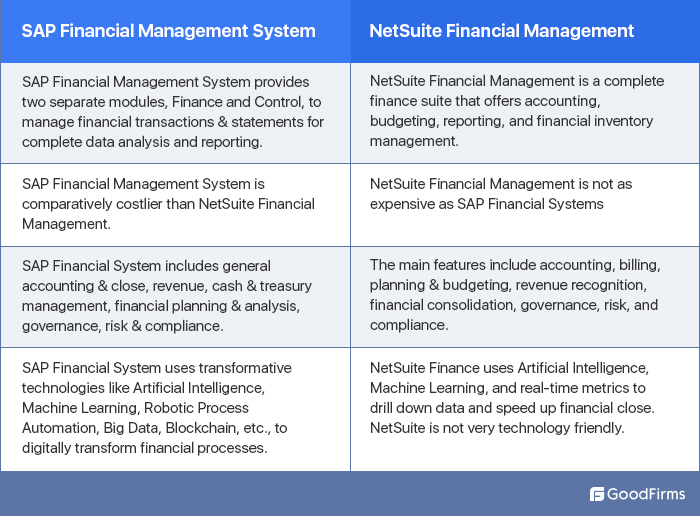
Final Verdict for SAP Financial Management System
SAP Financial Management System has intelligently automated all financial processes, including accounting and risk management. It has further streamlined various other tasks, such as billing and invoice management, optimizing the cash management and its flow, and providing accurate forecasting, planning, and budgeting. However, it needs to simplify reporting and make the user interface friendlier.
GoodFirms’ Review of SAP CRM and Customer Experience
The journey of SAP CRM commenced when SAP acquired Hybris in 2013. However, it was launched as an SAP C/4HANA solution in June 2018 to be integrated with SAP S/4HANA. SAP CRM provides real-time customer data and relevant business insights, allowing organizations to seamlessly connect with potential customers at every touch point and boost their experience. The CRM Software also aims to enhance customer retention and loyalty, increasing overall brand value.
SAP CRM and customer experience solution uses artificial intelligence to create complete customer profiles and understand their personal preferences. You can increase customer engagement by analyzing their journeys and following the privacy regulations.

Image Source: SAP CRM & CX
Gartner has named SAP a Leader in Magic Quadrant for Digital Commerce and Sales Force Automation in 2021.
A customer said this about SAP CRM and CX solutions.
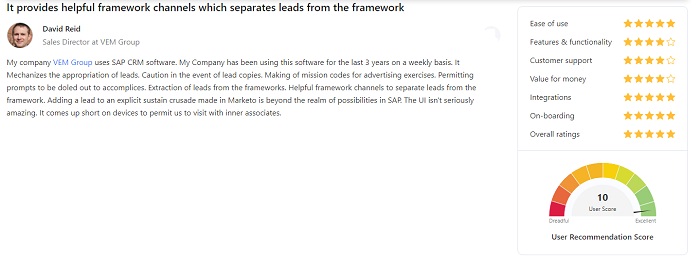
Can SAP CRM and CX Enhance Customer Relationships and Provide Optimal Customer Experience?
SAP CRM and CX have various advanced capabilities to boost customer relationships, such as lead management, contact management, CRM integrations, workflow automation, interaction management, customer analytics, mobile CRM, and CRM integrations. SAP offers the best-in-class tools for collaboration and personalization. The organization can integrate and manage sales, e-commerce, customer service, and marketing to automate customer-centric activities.
The Critical Components of SAP CRM and CX
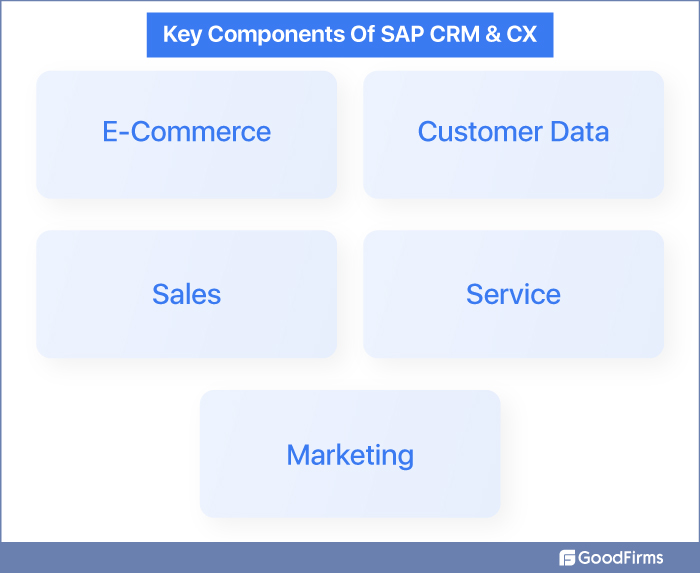
Customer Data Management
Customer Data Solutions and Management lets you leverage information seamlessly across the enterprise, score improved leads, and combine operational data to make informed decisions and get a 360-degree view of all your customers. You can look to surge revenue and accomplish the set targets with enhanced customer trust, unified customer profiles, data privacy, and compliance, customer identity, and access management.
E-Commerce Platform
SAP offers enterprise-grade, scalable, intuitive e-commerce software that allows businesses to elevate their e-commerce platform, make it more agile and customer-centric. Online businesses can easily adapt and implement the latest e-commerce trends, focusing on revenue growth opportunities, unleashing data-driven intelligence benefits, and digitizing product sales and services powered by the Internet of Things and other connected technologies.
Customer Engagement Marketing
SAP Marketing solutions help organizations identify the right target audiences, and attract, convert, and retain them through viable marketing campaigns and channels. The marketing tool helps to enhance customer loyalty and lifetime value to gain measurable outcomes. SAP Emarsys Customer Engagement platform enables marketing teams to create personalized customer experiences supported by pre-built analytics and use cases. Also, AI-powered data simplifies customer segmentation and optimizes marketing technologies.
Sales Automation
If you want to convert potential customers into brand advocates, SAP provides a sales automation solution to maximize sales and improve customer and seller experiences. The software helps sales reps and teams to adapt quickly to the fast-changing customer demands and market landscape by focusing on redefining the sales journey and accelerating time to market. The sales reps can interact with customers with real-time data to provide high-scalable support.
Apart from this, SAP Sales Cloud offers an exceptional sales experience with digital selling, intelligent prioritization, and a centralized personalized engine. It further includes intelligent forecasting, pipeline manager, and guided selling with comprehensive support from interactive analytics and account insights.
SAP Service Cloud
SAP Service Cloud plays a vital role in augmenting brand reputation and building customer engagement by delivering brand promise and boosting loyalty. The solution allows businesses to engage customers on their preferred channel., collaborate efficiently to resolve an issue, and minimize the cost of customer services. SAP allows users to implement advanced technologies to speed up the services, while the flexibility and scalability of the platform provide more agility.
SAP CRM & CX: Pros & Cons

SAP CRM vs. SalesForce CRM
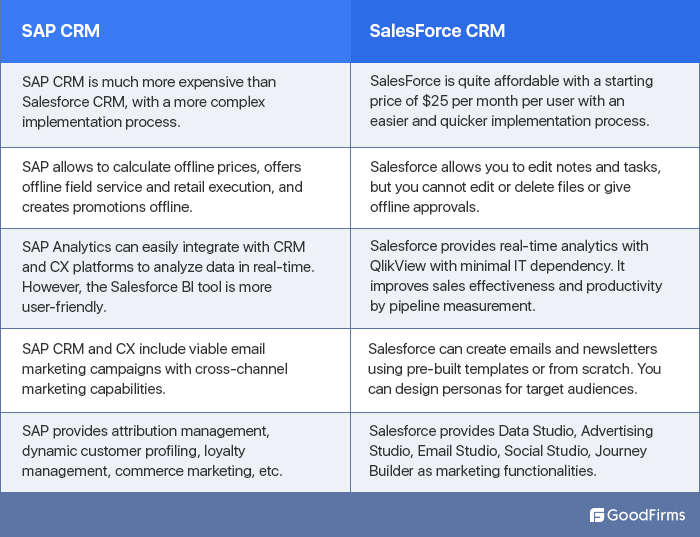
Final Verdict for SAP CRM and CX Platform

GoodFirms has given a 5-star rating for SAP CRM based on actual users’ feedback and reviews. SAP CRM and CX Platform allow enterprises to strengthen their customer relationships and improve customer and brand loyalty with customer analytics, social media collaboration, and personalization. It amplifies customer experience and customer retention through a 360-degree view and artificial intelligence technologies. However, it has to make its marketing platform more user-friendly and simplify the implementation of the platform.
GoodFirms Review of SAP Spend Management
Every organization wants to spend intelligently and viably with an aim to maximize its available resources. It is where SAP Spend Management solutions or SAP Ariba can help you accomplish your goal. SAP automates the spending process and, at the same time, provides greater control over expenditure to enhance savings. The automation helps to mitigate all errors and lowers the cost of supply and risks.
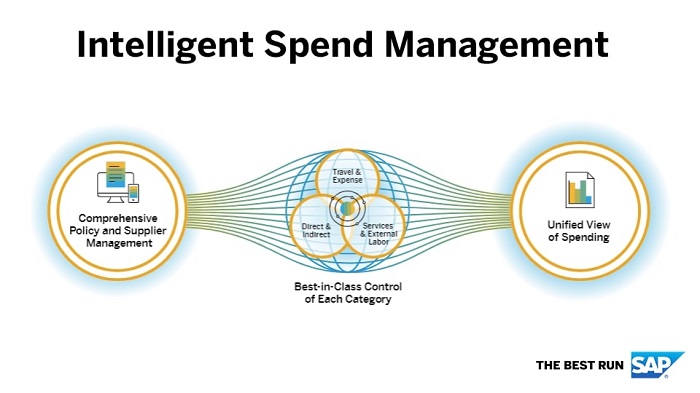
Image Source: SAP Spend Management
Similarly, you efficiently manage the workforce with better control than SAP Fieldglass, while SAP Concur allows you to manage travel and expenses intelligently. It is a next-generation tool that lets you manage all supplier relationships, complete procurement, and company purchasing so that you can identify and analyze each dollar spent on buying a product or a service.
SAP Ariba offers a larger and clearer view of procurement and spending with complete visibility so that you can make smarter decisions based on key metrics and AI-powered insights. The expense management tool offers a seamless integration with the backend system, procure-to-pay process, and partner solutions.
Does SAP Spend Management Simplify, Manage, and Optimize all Spend Processes?
With SAP Spend Management solutions, you get an in-depth understanding of all the challenges related to spending and manage them effectively. Also, SAP Ariba allows you to integrate direct and indirect procurement with SAP Fieldglass and respond to swiftly changing market conditions. Also, you can quickly remove all operational and financial discrepancies and optimize the buying experience with end-to-end visibility.
Check out an original customer review on SAP Concur

The Main Components of SAP Spend Management Solutions
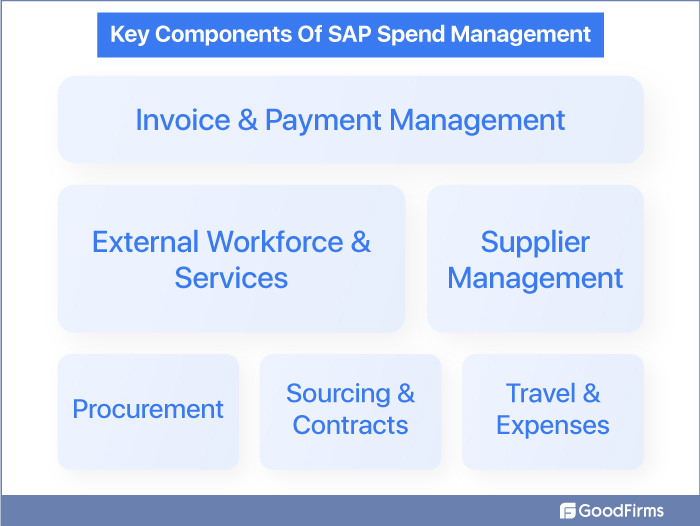
Invoice and Payment Management
You can automate your payment process to improve the account payable solution and strengthen supplier relationships to boost ROI and working capital outcomes. The component categorizes spend management into invoice management and discount management. It digitizes and captures invoice processes, and offers cloud-based workflow, financial reporting, invoice monitoring, preconfigured templates, etc. Discount Management provides dynamic discounting, a self-service supplier portal, payment terms management, and working capital management services.
Supplier Management
supplier management system is a one-st and comprehensive vendor management solution for efficiently managing your supplier lifecycle, and compliance, and reduces risks. The software streamlines supplier onboarding, performance management, and segmentation to improve operational efficiency. Supplier lifecycle management focuses on self-services for suppliers, two-way sync with SAP ERP, integration with procurement apps, and matrix-based management. Supplier risk management deals with proactive risk monitoring, collaborative risk disposition, protecting brand reputation, and risk due diligence.
Procurement Solutions
The procurement software from SAP simplifies and optimizes the procurement experience for all users, enabling them to curtail costs, enhance compliance, and align all spend categories to drive more visibility. The product is categorized into three categories based on its functionalities. These include Buying and Invoicing, Buying, and Catalog. The first category deals with invoice management, guided buying, spot buys, procurement operation desk, etc. Buying caters to almost the same functions as earlier, in addition to ERP integration for invoice management. The Catalog comes with API integration, intuitive user experience, catalog enablement, and rich content.
Sourcing and Contracts
The advanced sourcing and contracting feature coupled with spend analytics provides a robust and scalable procurement process The component streamlines direct and indirect material sourcing and product sourcing that includes process workflows, category management, project management tools, material dashboard, integrated contract, and supplier management. The feature also involves automated project initiation and negotiation process with contact management, spend analysis, free sourcing software, and a supplier directory.
External Workforce and Services
The Intelligent Spend Management offers a single unified view of all channels and categories enabled by digital technologies. SAP Fieldglass is a critical module of Intelligent Spend Management that focuses on managing the external workforce, service providers, and contingent workers. It is a modern vendor management system that offers more control over cost, increases productivity, manages compliance, and eliminates security risks.
Travel and Expense
Streamline travel expenses and efficiently manage invoices to redefine your travel experience with SAP Concur solutions, automate data entry, invoice generation, and payments to accelerate processing. Get real-time analytics, insights, and expense report solutions to speed up decision-making and conduct intelligent audits to gain more compliance and reduce fraud.
SAP Spend Management: Pros & Cons

SAP Ariba Vs. Oracle Procurement
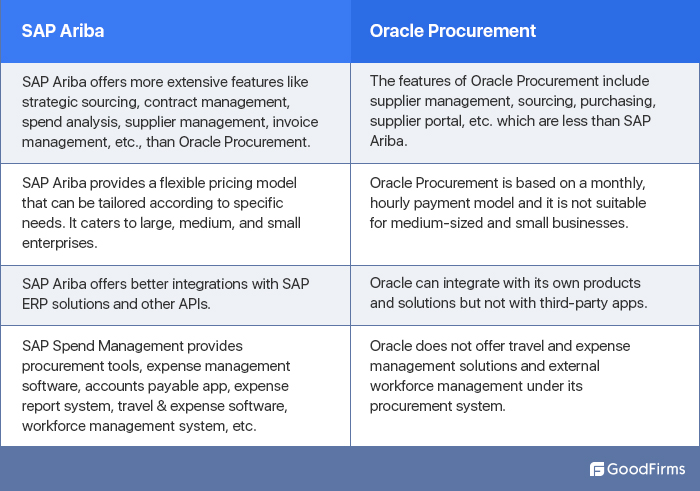
Final Verdict for SAP Spend Management

SAP Spend Management is a comprehensive software solution that provides you with a complete picture and analysis of direct and indirect spending, helps you efficiently manage external workforce and contingent labor, and intelligently handles travel and expenses with control over all types of expenditures. It means that you can unleash the advantages of SAP Ariba, SAP Concur, and SAP Fieldglass to make fast, informed decisions, fueled by end-to-end process integration and greater visibility into data.
GoodFirms Review of SAP Supply Chain Management
The cloud-powered and SaaS-based supply chain management system from SAP optimizes the entire supply chain process to cater to the fast-changing dynamic landscape. The software predominantly focuses on optimizing the supply chain planning and logistics, bolstering the network, and seamless connectivity between manufacturers, suppliers, business partners, and retailers. A resilient and sustainable supply chain management helps organizations to become more productive, competitive, and agile.

Image Source: SAP Supply Chain Management
SAP Supply Chain Management digitizes the flow of goods right from sourcing, production, and logistics, to transportation and shipping of the product to the end customer. SAP SCM plays a vital role in establishing coordination between all the links and modernizing critical supply chain activities like inventory management, warehousing, transportation management, fleet management, and customer service. Also, businesses can use this SAP solution for demand forecasting, helping to optimize order fulfillment.
SAP implements the best supply chain management practices, which are fueled by transformative technologies, such as Industry 4.0, artificial intelligence, machine learning, robotic process automation, and predictive analytics, etc., that improve workflows and speed up delivery times.
Here’s what a customer has to say about SAP SCM
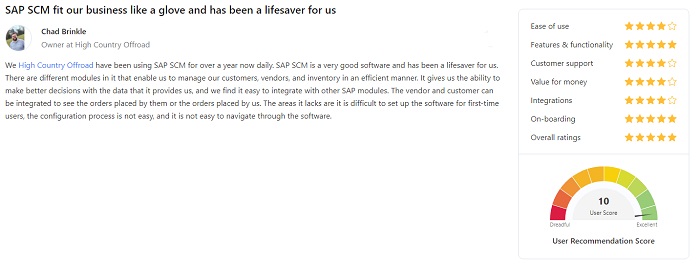
The Critical Modules of SAP SCM

Supply Chain Planning
SAP offers comprehensive planning and analytics capabilities that help you gain resilience and align supply chain planning across lines of business. By becoming more agile, you can quickly respond to disruptions in the supply chain network, product demand, and market conditions. SAP Integrated Business Planning for Supply Chain involves demand and forecasting management, a multi-echelon inventory management system, sales and operations planning, and response and supply planning. There is SAP S/4HANA Supply Chain for extended service parts planning to deal with parts supply and distribution logistics. SAP further offers priority-based order promising, optimized stock allocation, and analytics-driven decision support.
Supply Chain Logistics
The SAP logistics software help businesses manage their warehousing, order fulfillment, and goods distribution process, enhancing operational efficiency, identifying supply chain loopholes, and mitigating those. SAP Extended Warehouse Management includes internal and external logistics management and optimal storage operations. SAP Transportation Management deals with efficient transportation planning, execution, strategic freight, and order management. Logistics Network sends real-time alerts and notifications and provides freight logistics collaboration and global track and trace.
Integration and planning and order and appointment can be booked through yard management. In contrast, transportation resource planning involves
- Tracking vehicle movement and route optimization.
- Transportation resource planning.
- Supply and demand forecasting.
- Sending event-triggered alerts.
Availability to Promise provides an intelligent selection of the best alternative items.
Manufacturing
Production units looking to optimize their manufacturing can leverage SAP manufacturing software to digitize the process and minimize costs powered by Industrial Internet of Things (IIoT) solutions. Manufacturers can automate production and increase operational flexibility with SAP Digital Manufacturing Cloud, which aims to unify manufacturing models, reconcile data analytics, and offer integrated manufacturing operations management. The Industrial Internet of Things (IIoT) elevates overall equipment effectiveness and provides real-time energy monitoring, manufacturing analytics, and a platform.
Manufacturing units can gather automated data and centralize operations through a manufacturing execution system, whereas SAP offers production planning and scheduling, supported by SAP S/4HANA Manufacturing.
Product Lifecycle Development
This SAP Supply Chain Management module helps businesses to produce high-quality products using SAP's product lifecycle management software to escalate profitability and revenue. You can design customer-centric and various products to meet individual demands. You also get ample support from SAP Portfolio and Project Management, managing projects, resources, and complete portfolio management. SAP Product Lifecycle Costing helps to calculate the product cost and stimulation and provides pricing features and data modeling. In contrast, SAP Engineering Control Center provides an interface for authoring tools, intelligent process support, and integration features.
SAP Teamcenter by Simens provides Enterprise Product Lifecycle Management that includes managing electrical design and bills of materials. SAP S/4HANA product compliance helps manage hazardous goods, safeguard data sheets, and offer chemical compliance and product marketability. SAP Enterprise Product Development focuses on enhancing product collaboration and visualization, performing what-if simulations, and boosting design and development productivity.
Enterprise Asset Management
SAP Enterprise Asset Management system allows you to increase your assets' lifespan, enhance their uptime, and maximize their performance. The software helps you determine the assets’ health in real-time, powered by advanced technologies, such as predictive analytics, the internet of things, machine learning, and artificial intelligence. SAP Asset Performance Management eliminates the risks with AI-based predictive maintenance. In contrast, the field service management schedules and dispatches the workforce and provides intuitive dashboards, reports, and analytics apart from mobile field service. You can perform work order management, asset tracking, and geographical enablement.
SAP SCM: Pros & Cons

SAP SCM vs. Blue Yonder

Final Verdict for SAP Supply Chain Management

SAP Supply Chain Management has increased operational efficiency in different phases of the supply chain process, such as manufacturing, reducing the cost of raw materials, and improving product quality. It has lowered the transportation costs, but triggered the shipping time with effective forecasting and planning. All stakeholders can access real-time data information across the network to quickly address any bottlenecks if any. GoodFirms ranks this with a five-star rating based on the actual users’ feedback and reviews.
GoodFirms Review of SAP Human Capital Management (HCM)
For organizations planning to empower their human resource teams and innovate core HR functions, SAP has elevated and evolved its human capital management to the next level by introducing a new concept; Human Experience Management or HXM. HXM establishes a robust connection between the HR team and other business units to create a competent and productive workforce that plays a constructive role in upscaling the prospects and helping the company accomplish its goals.
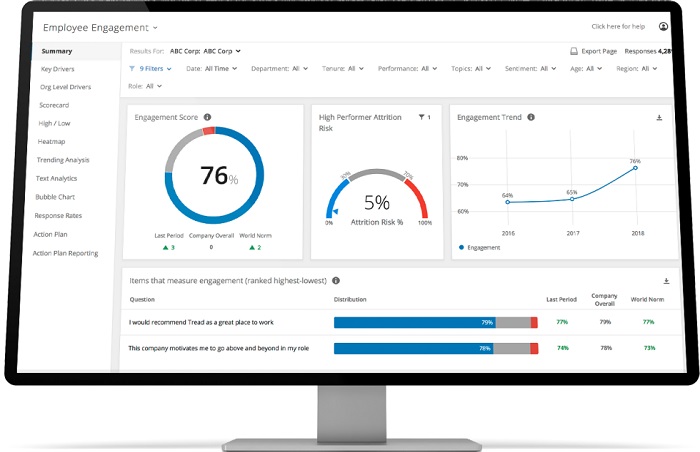
Image Source: SAP HCM
SAP HCM or SAP SuccessFactors also optimizes the payroll solutions, monitors time and attendance in real-time, and creates dynamic employee experience and engagement. The HR Suite is designed by understanding the employees’ needs, their working patterns, and factors that motivate them to do better. The HR platform supports employees throughout their careers and helps HR professionals to hire the best talent that improves business performance.
The software allows management and HR teams to efficiently manage the workforce and fully utilize the employees' potential by recruiting them to the right position. The tool simplifies and streamlines all HR administrative tasks enabling the team to implement the HR policies and compliance that corresponds with the company’s objectives.
Here is what a customer has to say about SAP HCM

Does SAP HXM or HCM provide the Next Level of Employee Experience and Create a Sustainable Workforce?
SAP HCM and SuccessFactors have evolved with the implementation of the best practices and use of intelligent technologies, data insights, guided workflows, and aligned business operations. It is helping organizations nurture employee skills and retain the best talent to take the set goals forward. Furthermore, the software has streamlined employee onboarding and allowed respective managers to review and evaluate their performance. They can easily approve or reject the leave requests and compensation requested by the employee in the system.
The workforce analytics allow higher management to identify the latest employee hiring and engaging trends and build strategic workforce planning.
The Key Components of SAP HCM
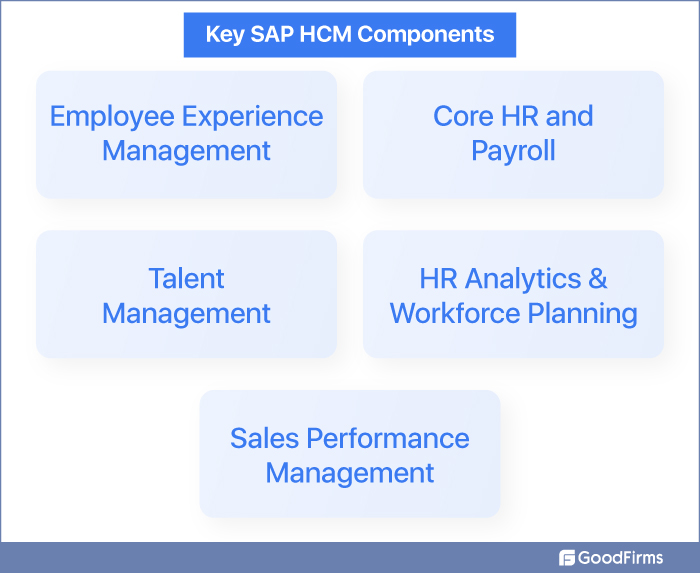
Employee Experience Management
An organization must create strategies to augment employee experience to retain a competent and productive workforce. SAP HCM integrates with employee engagement tools to make your workforce more resilient and efficient. SAP HXM provides automatic feedback assessments regarding the flow of work. SAP Qualtrics Employee Engagement provides flexible survey creation, role-bash dashboards, and guided action planning. SAP Qualtrics Employee Technology Experience offers augmented digital employee experience through customized data experts, critical driver analysis, AI-powered analytics, and real-time and real-time dashboards. It further manages the employee lifecycle, comprehensively assesses the performance, improves employee benefits, and enhances candidate experience.
Core HR and Payroll
SAP has made it easier to manage the global workforce with flexible and comprehensive core HR and payroll functionalities. It automates the HR process, provides an employee self-service portal, and enhances compliance. The central employee platform tracks real-time time and attendance and manages employee profiles and transactions. SAP has unified the payroll system with accurate monitoring and standardized processing. Managers can easily monitor hours worked and track timesheets and absences, all in one place.
SAP also offers embedded HR analytics and service-level agreement compliance in addition to the simplified document and compliance management. Organizations can provide everything that employees need to augment their experience and efficiency.
Talent Management
Organizations must retain employees having exceptional caliber and potential to deliver goal-oriented results. Talent management software helps companies recruit the best potential talents using advanced tools and, simultaneously, nurtures employee skills to make them feel special. It streamlines the hiring process to improve candidate experience and complete applicant management. The onboarding gets more straightforward with the digital process, pre-day one and new hire experiences, and better team collaboration.
Performance management includes guided action planning, comprehensive feedback and evaluations, and employee goal management. SAP also manages compensation and benefits through employee rewards and personal recognition programs. It acts as a learning platform providing modern experiences and an application that focuses on skill-based development planning.
HR Analytics & Workforce Planning
Workforce analytics solutions allow HR managers and professionals to quickly answer all workforce-related questions, adopt evidence-based decision-making, and discover the latest workforce trends. SAP SuccessFactors seamlessly integrates with SAP Analytics Cloud to create strategic workforce planning by analyzing and forecasting the demand and supply for the workforce and accessing the gaps. HR teams can identify the talent to build action plans and create a competent workforce corresponding to financial goals.
Sales Performance Management
As the name suggests, this SAP HCM module focuses on escalating sales performance using an automated process, intuitive user interface, territory, and quota solutions. The software provides embedded intelligence, pre-built workflow analytics, and personalized dashboards, helping sales reps deliver an agile experience to end customers. SAP helps to boost territory coverage, increase quota attainment, and minimize turnover. The incentive compensation management deals with streamlining the process and improving payment accuracy. The agent lifecycle management upsurges agent experience nullifies errors, and automates the compliance process.
What’s New in SAP SuccessFactors as of April 2022
- Users receive alerts on the reimaged home page, which informs them about the pending tasks for SAP SuccessFactors Employee Central. They don’t have to leave the home page.
- SAP has boosted contingent workers by providing the Configurable New Hire process. Users can configure the add contingent worker transaction using custom-built templates.
- The Hire-to-Retire process gets better with the additional support from master data integration services.
SAP HCM: Pros & Cons
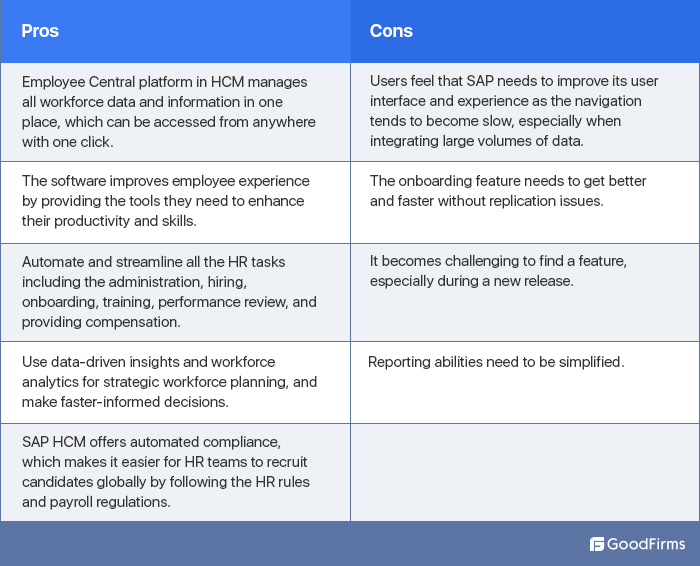
SAP SuccessFactors vs. Workday HCM

Final Verdict for SAP HCM

SAP has innovated Human Capital Management and taken HR solutions to the next level with the introduction of Human Experience Management (HXM). The software has automated several HR tasks to increase productivity and streamline the recruitment process with complete transparency. It has optimized the payroll process, reporting, and time management to simplify complex issues and get the best-desired outcomes.
GoodFirms Review of SAP Business Technology Platform
SAP Business Technology Platform or SAP BTP is a next-generation platform-as-a-service(PaaS) that can efficiently run on the cloud, on-premise, and third-party applications. It delivers microservices and in-memory capabilities, including SAP HANA and SAP S/4HANA core functionalities. Using the platform, you can convert data into valuable business insights, which helps you make real-time informed decisions. SAP introduced BTP solutions to replace the SAP Cloud Platform in January 2021 to innovate and streamline end-to-end business processes and unlock new opportunities.
SAP Business Technology Platform brings sustainability and agility into business operations with comprehensive support from embedded analytics and intelligent technologies. SAP BTP gets fueled and empowered by four core pillars that include
- Database and Data Management- Organizations can quickly and seamlessly store all their critical relevant data, which can be accessed, integrated, and interpreted anywhere. They can manage data at your convenience with SAP HANA and SAP HANA Cloud capabilities. They also get the SAP Data Warehouse Cloud facility, which provides a unified view of data across the organization.
- Analytics- SAP Analytics Cloud enables you to gather data from multiple sources, such as cloud databases, data warehouses, data lakes, etc., to integrate with third-party applications and market data using artificial intelligence and machine learning. It plays a a a significant role in planning, forecasting, and making data-driven decisions.
- Intelligent Technologies- SAP BTP uses popular advanced digital transformative technologies, including artificial intelligence, machine learning, robotic process automation, the internet of things, blockchain, etc., to automate manual and repetitive tasks, simplify complex processes, and focus on innovation.
- Application Development and Integration- This SAP BTP pillar aims to innovate, streamline, and make business operations more agile in both cloud and hybrid environments. It simplifies integration and extensibility to create new applications and design interactive user experiences.
The Essential Modules of SAP BTP
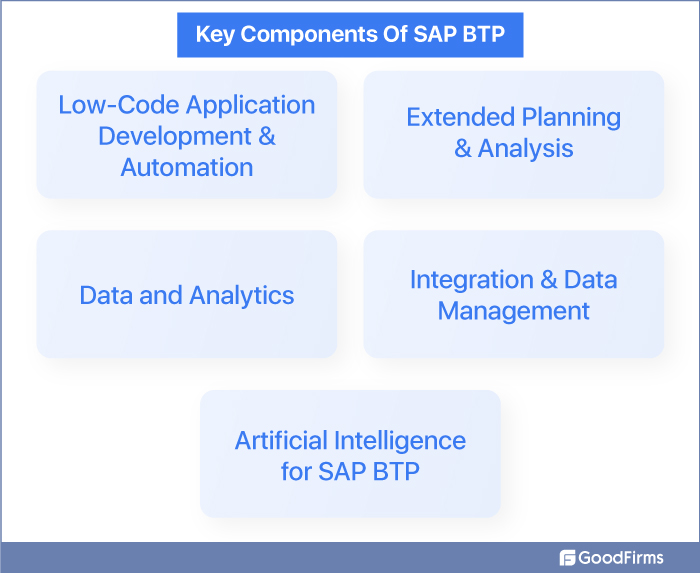
Low-Code Application Development & Automation
You can easily create applications of your choice with minimal or no coding using the low code development platform is from SAP BTP. The automation of tasks helps to lower the overall development costs, augments customer experience, and streamlines the procurement process. The no-code development platform provides visual tools for designing native and web apps, while artificial intelligence solutions automates the task with drag-and-drop tools and built-in specific content. The module offers pre-built templates for creating UI and UX designs and widgets with visual appeal.
Extended Planning & Analysis (xP&A)
The component aligns cross-extended enterprise planning, such as finance, supply chain, sales, and workforce to combine as one unified connected plan. It stimulates improved collaboration and boosts productivity. You can unleash live and accurate data to speed up the decision-making and create plans that correspond with the line of business. Generate automatic forecasts and stimulate scenarios to drive improved results.
Data and Analytics
The component allows organizations to derive more value from SAP data, which helps them in making more impactful decisions. Maximize the use of enterprise data and get all meaningful insights to enrich your business landscape. The solutions include SAP Analytics Cloud, SAP HANA Cloud, SAP Data Warehouse Cloud, SAP Data Intelligence Cloud, and SAP Master Data Governance. These solutions are backed by robust database technology with multi-cloud support, data management, analytics, and planning.
Integration and Data Management
Use SAP’s advanced integrated platform-as-a-service solution to seamlessly integrate data enterprise-wide to connect and process it. iPaaS aligns applications and processes with pre-built content, whereas Enterprise Data Integration helps to convert data into data insights to carry out different tasks, such as decision-making, planning, reporting, etc.
Artificial Intelligence for SAP BTP
Artificial Intelligence software from SAP BTP is empowering businesses to become more efficient, innovative, intelligent, and scalable. You can create AI-powered chatbots to streamline communication with customers and manage AI models centrally in one place. The vital AI capabilities and solutions include SAP AI Business Services, SAP AI Core, SAP AI Launchpad, and SAP Conversational AI.
SAP BTP Platform: Pros and Cons
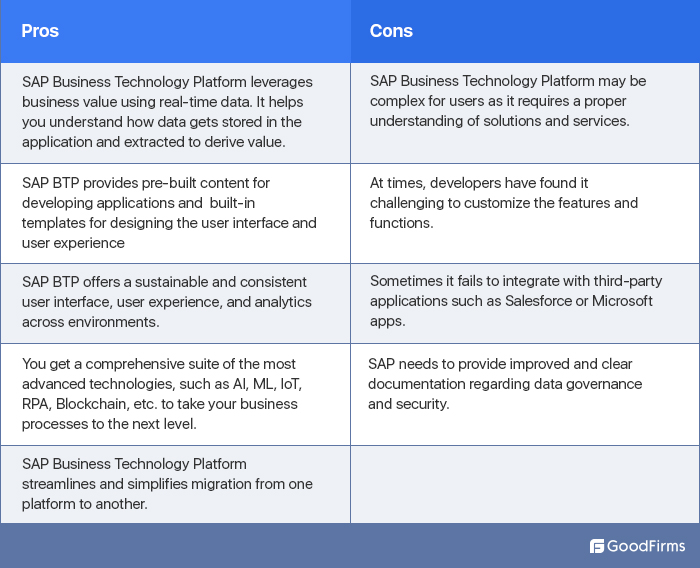
SAP BTP vs. Oracle OCI
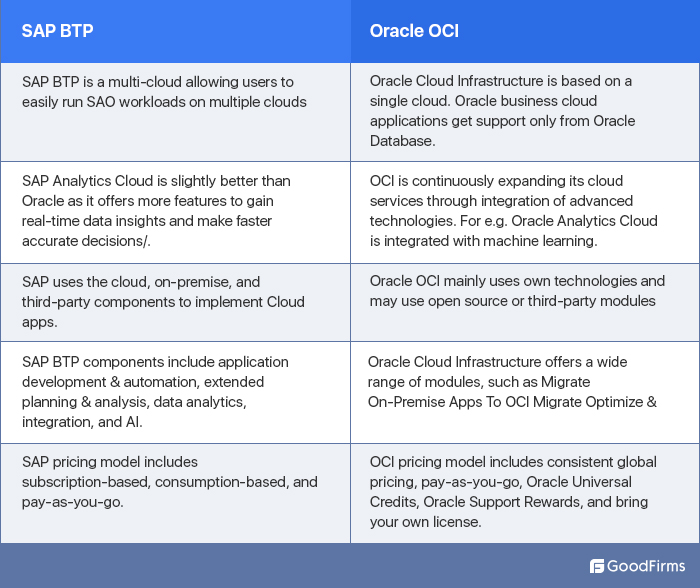
Final Verdict for SAP BTP
SAP Business Technology Platform has become more than a handy asset and tool for businesses willing to implement innovative technologies across functions. It has allowed IT firms to improve their enterprise integration and automate operations with no-code and first-code tools. It has enriched the user experience and enabled users to access real-time data across the board. However, SAP needs to work on improving the documentation and simplifying the customization of some features.
SAP Pricing Model
SAP has categorized the pricing model of cloud services into three distinctive categories. These include
- Subscription-based Pricing- Here, the prices of SAP Cloud services are fixed for a specific duration where you can use the service for a dedicated period, regardless of consumption. Before availing of this model, you have to decide which services you want to use and the time period. It can be monthly, annually, or hourly.
- Consumption-based Pricing- It is also known as Cloud Platform Enterprise Agreement (CPEA). Customers selecting this pricing model can use SAP Cloud Credits for the solutions and services in which they make the payment in advance without any contract amendments.
- Pay-as-You-Go- It is a more flexible and scalable pricing model where customers are only charged for the service they are using. There is no upfront payment.
SAP New Pricing Model
SAP introduced a new pricing model in April 2018 to access its digital licenses known as ‘Indirect Access.’ SAP wanted to simplify its pricing structure and make it more transparent for the end-users. It has addressed challenges related to the pricing model for Digital Access.
Customers get three different options under the new pricing model. These are
- Do Nothing or Status Quo- The pricing model suits all customers unwilling to change their contract policy and who wish to continue the existing license and follow terms and conditions.
- License Exchange- Customers willing to continue the current contract but exchange the existing license are not required for direct access to increase transparency during digital access.
- Contract Conversation- The pricing model is meant for users who want to add the value of the existing license to SAP S/4HANA for consolidation and new configuration of old contracts.
A Brief Summary about SAP
SAP is digitally transforming business operations with its ERP and technology platform solutions. It has empowered businesses to provide exceptional customer experience and service with innovative technologies, such as artificial intelligence, machine learning, robotic process automation, predictive analytics, and many more. Core business processes like finance, and supply chain, product lifecycle management, human resources, etc. have become streamlined and simplified for faster decision making and leverage of real-time data.
Are SAP Products Future-Ready? GoodFirms’ Final Take
It is encouraging to note that SAP has successfully established its dominance as a premier and leading provider of enterprise resource planning software solutions over the last five decades despite facing stern competition from Oracle. With its 50-year history, the largest non-American software company has become a frontline advocate for taking innovative technologies to the next level and empowering businesses to switch to a digital future. To accomplish this goal, it has partnered with top-notch tech giants, such as IBM, to digitize business operations and automate workflows, fueled by artificial intelligence, SAP S/4HANA, and IBM Cloud. Similarly, it has entered into a partnership with Google Cloud Platform to enhance native integration between SAP S/4HANA Cloud and Google Cloud Platform.
This is a masterstroke from SAP; which is helping the company to thrive and grow on two ends; first, it is making SAP software products future-ready to seamlessly incorporate the next-generation technologies, and secondly, SAP is preparing a tough battleground for Oracle Cloud Infrastructure for a neck-to-neck fight. Also, reviews and experts’ opinions suggest that SAP is friendlier, more flexible, and more scalable than Oracle in adapting to new technologies and the latest trends. With a perfect combination of legacy, transformation, and differentiators the company is all set to march ahead for the next 50 years with customer-based models.
But there are a few areas where SAP can focus on enhancing, to reduce the level of complexity, specifically while migrating from one SAP version to another. It has to improve the documentation process and provide users with more substantial resources and guides on the implementation and usage of the software solutions..
This comprehensive review of SAP by GoodFirms covers various software products of SAP; along with the comparison of three of SAP’s most prominent products with its competitors; Oracle, NetSuite ERP, and Salesforce CRM.
Also, if you are looking for popular business management software vendors; check out Zoho and Microsoft.
We have also reviewed two popular remote work solutions; Zoom and Zoho Meetings. The others in this list are Hubspot CRM, Xero, and Google Android Studio. You can go through these and provide your valuable comments or reviews on them.



